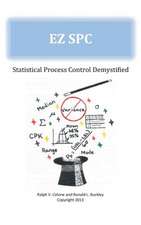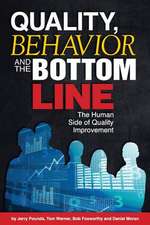Six Sigma in the Pharmaceutical Industry: Understanding, Reducing, and Controlling Variation in Pharmaceuticals and Biologics
Autor Brian K. Nunnally, John S. McConnellen Limba Engleză Paperback – 13 iun 2007
Designed primarily for the pharmaceutical industry, Six Sigma in the Pharmaceutical Industry: Understanding, Reducing, and Controlling Variation in Pharmaceuticals and Biologics provides the fundamentals of variation management and reduction in sufficient detail to assist in transforming established methodologies into new and efficient techniques.
Preț: 886.87 lei
Preț vechi: 1081.55 lei
-18% Nou
Puncte Express: 1330
Preț estimativ în valută:
169.70€ • 177.66$ • 140.42£
169.70€ • 177.66$ • 140.42£
Carte tipărită la comandă
Livrare economică 07-21 aprilie
Preluare comenzi: 021 569.72.76
Specificații
ISBN-13: 9781420054392
ISBN-10: 1420054392
Pagini: 220
Ilustrații: 87 b/w images, 16 tables and 39 equations
Dimensiuni: 156 x 234 x 13 mm
Greutate: 0.32 kg
Ediția:1
Editura: CRC Press
Colecția CRC Press
Locul publicării:Boca Raton, United States
ISBN-10: 1420054392
Pagini: 220
Ilustrații: 87 b/w images, 16 tables and 39 equations
Dimensiuni: 156 x 234 x 13 mm
Greutate: 0.32 kg
Ediția:1
Editura: CRC Press
Colecția CRC Press
Locul publicării:Boca Raton, United States
Public țintă
Academic, Professional, and Professional Practice & DevelopmentCuprins
The Enormous Initial Mistake, The Origins of Six Sigma, Evolution, Revolution, Paradox, Action and Reaction, Close Enough; … Or On Target?, Make More…Faster, Case Studies, The Camera Always Lies, Keeping It Simple, Why Use Control Charts?, Average and Range Control Charts, Origins and Theory, Charts for Individuals, Practical Considerations, Improving Laboratories, Beyond Compliance, Appendices
Notă biografică
John S. McConnell, Brian K. Nunnally
Descriere
Six Sigma in the Pharmaceutical Industry is the first book to introduce the fundamentals of Six Sigma, examine control chart theory and practice, and explain the concept of variation management and reduction applied specifically to the pharmaceutical industry. The first half lays out a conceptual framework for understanding variation, while the second half introduces control chart theory and practice. Using case studies and statistics, the book illustrates the concepts and explains their application to actual workplace improvements. Providing the basis for a complete operating philosophy, this book focuses on core concepts and their implementation to improve the existing products and processes in the pharmaceutical industry.

















